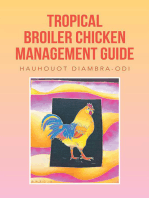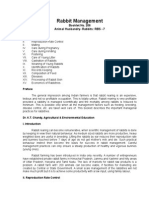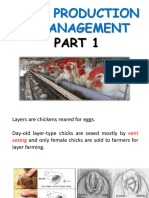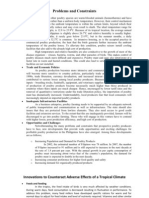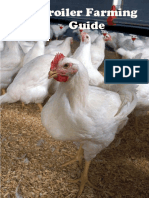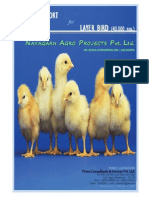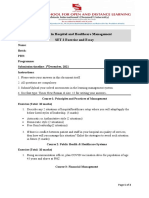Poultry Production
Poultry Production
Uploaded by
Briones Marc RainierCopyright:
Available Formats
Poultry Production
Poultry Production
Uploaded by
Briones Marc RainierOriginal Description:
Original Title
Copyright
Available Formats
Share this document
Did you find this document useful?
Is this content inappropriate?
Copyright:
Available Formats
Poultry Production
Poultry Production
Uploaded by
Briones Marc RainierCopyright:
Available Formats
SOUTHERN LUZON STATE UNIVERSITY
POLILLO, CAMPUS
POLILLO, QUEZON
POULTRY AND LIVESTOCK HOUSES, FIXTURES AND
EQUIPMENT
Poultry House Construction
BRIONES, MARC RAINIER R
Need for poultry house
To protect birds from adverse climatic conditions
To ensure easy and economic operation
To ensure scientific feeding in a controlled manner
To facilitate proper micro-climatic conditions in a near vicinity of bird
For effective disease control measures
To ensure proper supervision
Selection of location
Poultry house should be located away from residential and industrial area.
It should have proper road facilities.
EDUKASYONG PANTAHANAN AT PANGKABUHAYAN
SOUTHERN LUZON STATE UNIVERSITY
POLILLO, CAMPUS
POLILLO, QUEZON
It should have the basic amenities like water and electricity.
Availability of farm labourers at relatively cheaper wages.
Poultry house should be located in an elevated area and there should not be
any water-logging.
It should have proper ventilation.
Layout of poultry farm
A small size poultry farm doesn’t require any special layout as it involves
construction of only one house. The medium and large size farms require special
considerations for placement of building in the farm premises. The basic
principles to be observed for layout are
Layout should not allow visitors or outside vehicles near the birds.
The sheds should be so located that the fresh air first passes through the brooder
shed, followed by grower and layer sheds. This prevents the spread of diseases
from layer houses to brooder house.
There should be a minimum distance of 50-100 feet between chick and grower
shed and the distance between grower and layer sheds should be of minimum 100
metre.
The egg store room, office room and the feed store room should be located near
entrance to minimize the movement of people around the poultry sheds.
The disposal pit and sick room should be constructed only at the extreme end of
the site.
Different types of poultry houses
Brooder / chick house-It is used to brood and rear egg-type chicks from 0 to 8
weeks of age.
Grower house-It is used to grow egg-type birds from 9 to 18 weeks of age.
Brooders cum grower house-Here, the birds are reared from 0 to 18 weeks of age
(entire brooding and growing period of egg-type chicken).
Layer house-In which birds over 18 weeks of age are reared, usually up to 72
weeks of age.
Broiler house-In which broilers are reared up to 6 weeks of age.
EDUKASYONG PANTAHANAN AT PANGKABUHAYAN
SOUTHERN LUZON STATE UNIVERSITY
POLILLO, CAMPUS
POLILLO, QUEZON
Breeder house-In which both male and female breeders are maintained at
appropriate sex ratio.
Environmentally controlled (EC) house-In which, entire environment is
manipulated in such a way that is optimum for the birds growth.
Optimal environmental conditions for rearing broilers
Temperature - 22-300C (70-850F)
Relative Humidity - 30-60 %
Ammonia level - Less than 25 ppm
Litter moisture - 15-25%
Air flow - 10-30 metres/minute
House Orientation (Direction)
The poultry house should be located in such a way that long axis is in east-west
direction. This will prevent the direct sunshine over the birds.
Size
Each broiler require one square foot of floor space while a layer requires two
square feet of floor space under deep-litter system of rearing. So the size of the
house depends on the number of birds to be reared.
Length
The length of the house can be of any extent. The number of birds reared
and availability of the land determines the length of poultry house.
Width
The open sided poultry houses in tropical countries should have a width not
more than 22 to 25 feet in order to allow ample ventilation and aeration at the mid-
portion. Sheds wider than this will not provide adequate ventilation during the hot
weather. If the width of the shed is more than 25 feet, ridge ventilation at the
middle line of the roof top with proper overhang is a must. Hot air and obnoxious
gases which are lighter than air move upward and escape through ridge ventilation.
EDUKASYONG PANTAHANAN AT PANGKABUHAYAN
SOUTHERN LUZON STATE UNIVERSITY
POLILLO, CAMPUS
POLILLO, QUEZON
In environmentally controlled poultry houses, the width of the house may be even
40 feet or more since the ventilation is controlled with the help of exhaust fans.
Height
The height of the sides from foundation to the roof line should be 6 to 7 feet
(eaves height) and at the centre 10 to 12 feet. In case of cage houses, the height is
decided by the type of cage arrangements (3 tier or 4 tier).
Foundation
Good foundation is essential to prevent seepage of water into the poultry sheds.
The foundation of the house should of concrete with 1 to 1.5 feet below the surface
and 1 to 1.5 feet above the ground level.
Floor
The floor should be made of concrete with rat proof device and free from
dampness. The floor of the house should be extended 1.5 feet outside the wall on
all sides to prevent rat and snake problems.
Doors
The door must be open outside in case of deep-litter poultry houses. The size
of door is preferably 6 x 2.5 feet. At the entry, a foot bath should be constructed to
fill with a disinfectant.
Side walls
The side wall should be of 1-1.5 feet height, and generally at the level of
bird’s back height. This side wall protects the bird during rainy days or chill
climate and also provides sufficient ventilation. In case of cage houses, no side
wall is needed.
Roof
The roof of the poultry house may be thatched, tiled, asbestos or concrete
one depending upon the cost involvement. Different types of roofs are Shed,
Gable, half-monitor, full-monitor (Monitor), Flat concrete, Gambrel, Gothic etc.
Gable type is mostly preferred in tropical countries like India.
Lighting
EDUKASYONG PANTAHANAN AT PANGKABUHAYAN
SOUTHERN LUZON STATE UNIVERSITY
POLILLO, CAMPUS
POLILLO, QUEZON
Light should be provided at 7-8 feet above the ground level and must be
hanged from ceiling. If incandescent bulbs are used, the interval between two
bulbs is 10 feet. In case of fluorescent lights (tube lights) the interval is 15 feet.
Systems of Poultry Housing
Poultry can be housed under different systems based on following factors,
Availability of land
Cost of land
Type of farming activity
Climatic condition
Labour availability
Broadly, poultry housing systems are classified into three systems:
Free range or extensive system
Semi-intensive system
Intensive system
Deep-litter system
Slatted floor system
Slat cum litter system
Cage system
1) Free range system
This system is adopted only when adequate land is available to ensure
desired stocking density by avoiding overcrowding. We can rear about 250 adult
birds per hectare. A range provides shelter, greens, feed, water and shade.
Foraging is the major source of feeding for birds. Shelter is usually provided by
temporary roofing supported by ordinary poles. The fields are generally used on
rotational basis after harvesting of crops by moving of birds from one field to
another depending on cropping programme. All categories of birds can be reared in
this system. This system is most preferred for organic egg production.
Advantages
EDUKASYONG PANTAHANAN AT PANGKABUHAYAN
SOUTHERN LUZON STATE UNIVERSITY
POLILLO, CAMPUS
POLILLO, QUEZON
Less capital investment
Cost of housing is least.
Feed requirements are less since birds can consume fairly good amount of feed
from grass land.
Fertility of soil can be maintained.
Disadvantages
The scientific management practices can not be adopted.
Eggs are lost when laid inside the dense grasses unless special nests are provided.
Losses due to predatory animals are more.
Wild birds may bring diseases unless proper care is taken.
2) Semi-intensive system
As the name indicates birds are half-way reared in houses and half-way on
ground or range, i.e. birds are confined to houses in night or as per need and they
are also given access to runs. The houses are with solid floors while runs are fields
only. The success of rearing depends on maintenance of condition of runs to
reduce the contamination. Runs can also be used on turn basis. The stocking
density rate on an average for adult birds is 750 per hectare. This system is usually
adopted for duck rearing. The feeding and watering facilities are provided in the
pen.
Advantages
More economical use of land compared to free range system
Protection of birds from extreme climatic conditions
Control over scientific operation is some extent possible
Disadvantages
High cost for fencing.
Need for routine cleaning and removal of litter material from the pen.
3) Intensive system
Birds are totally confined to houses either on ground / floor or on wire-
netting floor in cages or on slats. It is the most efficient, convenient and
economical system for modern poultry production with huge numbers.
EDUKASYONG PANTAHANAN AT PANGKABUHAYAN
SOUTHERN LUZON STATE UNIVERSITY
POLILLO, CAMPUS
POLILLO, QUEZON
Advantages
Minimum land is required for farming.
Farms can be located near market area.
Day-to-day management is easier.
The production performance is higher as more energy is saved due to restricted
movements.
Scientific management practices like breeding, feeding, medication, culling etc.
can be applied easily and accurately.
The sick birds can be detected, isolated and treated easily.
Disadvantages
Birds’ welfare is affected. They cannot perform the natural behaviour like
roosting, spreading wings, scratching the floor with legs etc.
Since they are not exposed to outside sunlight and feed sources, all the nutrients
should be provided in balanced manner to avoid nutritionally deficient diseases.
Chances for spreading of diseases are more.
Poultry Farm Equipments
Incubation equipments
Setter
It is a machine in which proper temperature, humidity and turning are provided for
the first 19 days of incubating chicken egg.
2. Hatcher
It is similar to that of setter but turning mechanism is not available and the trays
are designed to hold the newly hatched chicks.
Here, the eggs are placed for the last three days of incubation.
Various styles of setter and hatcher found around the world include,
Walk-in or Corridor incubators
Tunnel type incubators
Vertical fan incubators
3. Compressed air system
Some incubators require compressed air to actuate the turning mechanism for the
racks of eggs.
EDUKASYONG PANTAHANAN AT PANGKABUHAYAN
SOUTHERN LUZON STATE UNIVERSITY
POLILLO, CAMPUS
POLILLO, QUEZON
A large central compressed air system is needed for blowing down dust and other
dry cleaning in the hatchery.
4. Emergency standby electric plants
When there is a failure in the local electrical supply, the incubators must have a
secondary source of electricity.
Therefore, a standby electrical generator located on site, generally within, or next
to the hatchery building is imperative. The standby electrical generator should have
the capacity to support the all essential services of the hatchery.
5. Hatchery automation equipments
Hatcher tray washers Waste removal systems Egg transfer machines In ovo
vaccination equipment Chick box washers Rack washers Vaccinating / sexing /
Grading systems High pressure pumps
Egg candler
It is a lighting device, used to find out the internal structure of eggs.
Two types of egg candlers are available, individual and mass candlers
Brooder equipments
Equipment used to provide warmth and light and to rear the baby chicks during the
first few weeks of life are called brooders.
The brooders consist of some heating source, reflectors to reflect the heat and light
towards the chicks, light and heat adjustment devices such as stands, thermostats
and other accessories, depending on the model.
Different equipment used for brooding are,
1. Charcoal stove / kerosene stove
These are used in places where electricity is not available or costly and
where power failure is quite common.
These stoves are covered with plates or pans to sustain the heat in the
brooding area.
2. Gas brooder
Natural gas, LPG or methane is connected to heating element which is
hanged 3 to 5 feet above the chick to provide heat.
It is attached with canopy type reflectors to reflect the heat towards the
chicks.
3. Electrical brooder
EDUKASYONG PANTAHANAN AT PANGKABUHAYAN
SOUTHERN LUZON STATE UNIVERSITY
POLILLO, CAMPUS
POLILLO, QUEZON
It is also thermostatically controlled heating system that spread required
amount of heat uniformly above large area, this avoid crowding of chicks
under brooder directly.
One electrical brooder can be used for 300 to 400 chicks.
4. Infra-red bulbs
It is a self reflecting bulb and hence no need of reflector over the bulbs.
150 and 250 watt bulbs are available to provide sufficient heat to 150 and
250 chicks, respectively.
5. Reflectors/ Hovers
These reflectors are called Hovers.
These are reflectors of heat and light.
i).Flat type hover
These hovers are flat provided with heating element, heating mechanism and
pilot lamp and in some cases thermometer are also there in order to record
the temperature.
Generally they are mounted with stands on all four corners, instead of
hanging from the roof.
ii).Canopy type hover
These reflectors are in concave shape consisting of ordinary electrical bulb,
thermostat mechanism and in some cases thermometer.
6. Brooder guard / chick guard
These are thin sheets of metal, hard board, or bamboo mat of 1 to 1.5 feet
height and varying in lengths.
They are used to restrict the movement of chicks, so that the chicks will be
kept closer to the brooders and prevent them from chilling.
They are used to prevent chicks from straying too far away from heat supply
until they learn the source of heat.
We have to provide brooder guard with a diameter of 5 feet, height of the
brooder should not exceed 1.5 feet.
For this purpose, we can use materials like cardboard sheet, GI sheet, wire
mesh, and mat etc. depending upon the season of brooding.
During summer season, brooding is done for 5-6 days. In winter season it is
2-3 weeks.
7. Electrical heaters (heating rods or coils)
EDUKASYONG PANTAHANAN AT PANGKABUHAYAN
SOUTHERN LUZON STATE UNIVERSITY
POLILLO, CAMPUS
POLILLO, QUEZON
This type of brooder is provided with heating elements and pilot lamps and
in some cases thermometer is provided to record the temperature.
They used to have a reflecting device over the heating rods or coils.
The temperature can be adjusted depending on the requirement.
Feeding equipments
Feeders are equipment used to feed the birds, by placing feed in them.
They may be conventional, semi-automatic of various designs and shapes
and made up of either metal or plastic.
Different feeding equipment are,
1. Automatic feeder
In case of automatic feeder the feed is supplied to the entire length of the
poultry house by specially designed feed troughs with auger type or chain
type devices to move the feed from the feed bins to the other end.
These are operated with electricity and the height of the feeder can be
adjusted depending upon the age of the birds.
2. Linear feed
Different sizes of linear feeder with guards are available.
Provision is also made to adjust the height of the feeder.
Linear feeders are usually made of Galvanized Iron. However it can as
well be made out of any locally available material like wood, bamboo,
etc.
Provisions for stability and adjustment in height at which the feeder
stands have to be made in its design.
Birds can stand on either side of the linear feeder.
Total feeder space available = 2* length.
No of linear feeders = (2*Length of the feeder) ÷ Feeder space with all
measurements in cm.
3. Circular feeder
These are semi-automatic feeders and can hold 5 to 7 kg feed in its cone
at a time.
The feed is slowly delivered to the bottom by gravity.
It can also be attached with feed grills to prevent wastage.
EDUKASYONG PANTAHANAN AT PANGKABUHAYAN
SOUTHERN LUZON STATE UNIVERSITY
POLILLO, CAMPUS
POLILLO, QUEZON
These are made of high plastic and usually suspended from roof/ roof-
truss or from separate pipeline for the purpose.
These are also called as ‘hanging feeders’.
These feeders are available in different capacity and when completely
full, the feed will suffice 4 to 7 days, depending upon the age and number
feeding on them.
The height at which the feed is available can be easily adjusted by simple
clamp mechanism.
Plastic feeders will be brightly colored (red or blue, generally) and hence
are expected to attract layers, especially chicks to feed.
No. of hanging feeders = 1.3* (Circumference ÷ Feeder space) with all
measurements in cm.
30% more birds can be accommodated in a hanging feeder when
compared to that in linear feeder.
4. Shell grit box
It is used to provide shell grit to the layer birds as a supplemental source
of calcium
Water equipments
Water with high total dissolved solids will cause deposits on the humidity
controls, spray nozzles, jets and valve seats.
Therefore filter systems and water softeners are necessary to reduce the TDS
content of the water used for hatchery operations.
1. Plant and jar type
This type of waterer is circular in nature, having two compartments i.e.
jar for filling water and pan for delivering water.
2. Linear waterer / Channel type waterers
This type waterer is usually attached with cages for providing continuous
water supply.
One end of channel type waterer is designed as funnel shape to receive
water from a tap and the other end has the provision for draining the
excess water.
3. Water basin made of plastic / wood/GI with grill
EDUKASYONG PANTAHANAN AT PANGKABUHAYAN
SOUTHERN LUZON STATE UNIVERSITY
POLILLO, CAMPUS
POLILLO, QUEZON
Basins of different diameters are available (10”, 12”, 14” and 16”
diameter).
A separate grill is available to prevent the entry of birds inside the water.
4. Bell type automatic waterer
These are made of high-impact plastic in a bell shape usually suspended
from separate pipeline for the purpose.
This type of waterers has control over the water flow and maintains the
required water level always.
There will be a continuous flow of water so as to ensure water available
for the birds throughout the day.
Height at which the water is available can be easily adjusted by simple
clamp mechanism and rate of flow water is adjustable by a valve (spring-
mounted). Plastic drinkers will be brightly colored (red,blue) and hence
are expected to attract layers, especially chicks to water.
No. of bell-drinkers=1.3*(circumference÷ Drinker space)
5. Nipple drinker
http://www.agritech.tnau.ac.in/expert_system/poultry/Poultry%20Farm%20Equipments.html
EDUKASYONG PANTAHANAN AT PANGKABUHAYAN
You might also like
- Medical Spa Business PlanDocument48 pagesMedical Spa Business PlanJoseph QuillNo ratings yet
- Catalog DermaLab ComboDocument2 pagesCatalog DermaLab ComboMohd Khidir GazaliNo ratings yet
- AA BroilerPerfObj2012R1 PDFDocument12 pagesAA BroilerPerfObj2012R1 PDFAmine FettahNo ratings yet
- Goat Fattening FarmDocument18 pagesGoat Fattening FarmZohaib Pervaiz100% (2)
- Agriculture Business WeekDocument10 pagesAgriculture Business WeekadajariaNo ratings yet
- Guideline On Building A Poultry HouseDocument3 pagesGuideline On Building A Poultry HouseWMS Ideal100% (1)
- Egg Incubation for the Poultry Keeper - A Collection of Articles on the Methods and Equipment of Natural and Artificial IncubationFrom EverandEgg Incubation for the Poultry Keeper - A Collection of Articles on the Methods and Equipment of Natural and Artificial IncubationNo ratings yet
- Tropical Broiler Chicken Management GuideFrom EverandTropical Broiler Chicken Management GuideRating: 1 out of 5 stars1/5 (1)
- Raise pigs: a beginner's guide, with human and healthy techniques for raising a pig to get meat, and understand how to also earn moneyFrom EverandRaise pigs: a beginner's guide, with human and healthy techniques for raising a pig to get meat, and understand how to also earn moneyNo ratings yet
- Eggs Incubators: Ecochicks Poultry 120 Quail Eggs Capacity Jn2-60Document2 pagesEggs Incubators: Ecochicks Poultry 120 Quail Eggs Capacity Jn2-60iccanxNo ratings yet
- Commercial Rabbit Production PDFDocument13 pagesCommercial Rabbit Production PDFRobert D. Beasley100% (3)
- HHD 56 Egg Fully Automatic Poultry IncubatorDocument12 pagesHHD 56 Egg Fully Automatic Poultry Incubatormekahli mehdiNo ratings yet
- BV 300 Layer Management Guide: Types of HousingDocument20 pagesBV 300 Layer Management Guide: Types of HousingBINAY KUMAR YADAV100% (1)
- Surehatch Pricelist 2020 PDFDocument23 pagesSurehatch Pricelist 2020 PDFHadrien Faryala100% (1)
- BV 300 Layer Management GuideDocument27 pagesBV 300 Layer Management GuideAyush SharmaNo ratings yet
- AA Plus Breeder Supplement PDFDocument12 pagesAA Plus Breeder Supplement PDFNader SedighiNo ratings yet
- Hatchery Management GuideDocument10 pagesHatchery Management GuideAeon Systems100% (1)
- Rabbit Management 206Document9 pagesRabbit Management 206Navneet Kour100% (1)
- Methods of BreedingDocument28 pagesMethods of BreedingNicole Richardson100% (1)
- AA Broiler Handbook2014i EN PDFDocument148 pagesAA Broiler Handbook2014i EN PDFGirish Kumar100% (1)
- Basic Management of Poultry in Developing CommunitiesDocument138 pagesBasic Management of Poultry in Developing Communitiesridwan muntheNo ratings yet
- Cobb Broiler Management Guide - english234A91C1CA4A90EAC1C467D7 PDFDocument73 pagesCobb Broiler Management Guide - english234A91C1CA4A90EAC1C467D7 PDFOke At HassanNo ratings yet
- Brooding and Rearing Baby ChicksDocument4 pagesBrooding and Rearing Baby ChicksRaymond KatabaziNo ratings yet
- BV 300 ManagementDocument61 pagesBV 300 Managementrajeevunnao100% (5)
- 8 - Layer Production Part 1Document29 pages8 - Layer Production Part 1France Dorothy SamortinNo ratings yet
- Pig Gilt and Sow ManualDocument42 pagesPig Gilt and Sow ManualAceNo ratings yet
- Hatchery ManagementDocument25 pagesHatchery ManagementRatikant NandaNo ratings yet
- Problems and Constraints in Poultry ProdDocument4 pagesProblems and Constraints in Poultry ProdNeverSad Ej Nadabar100% (2)
- Bovans White Cs Cage Product Guide L7150-2 PDFDocument48 pagesBovans White Cs Cage Product Guide L7150-2 PDFNarayan YadavNo ratings yet
- Ross 308 Broiler Performance Objectives PDFDocument24 pagesRoss 308 Broiler Performance Objectives PDFsazri81No ratings yet
- The ManualDocument12 pagesThe ManualDiana DainaNo ratings yet
- Broiler Farming Guide PDFDocument20 pagesBroiler Farming Guide PDFshubham kumarNo ratings yet
- Poultry Pocketbook 2017Document27 pagesPoultry Pocketbook 2017Dulce AmorNo ratings yet
- Problems and Prospects of Poultry Industry in BangladeshDocument16 pagesProblems and Prospects of Poultry Industry in BangladeshDr. Mohammad Shamsuddoha75% (4)
- Module 4 LivestockDocument37 pagesModule 4 LivestockDeejay BeekayNo ratings yet
- Basic Management of Intensive Poultry Production 11-14-16 PDFDocument176 pagesBasic Management of Intensive Poultry Production 11-14-16 PDFDiana DainaNo ratings yet
- Broiler Farm Production ManualDocument46 pagesBroiler Farm Production ManualAbdul Rahman Selamat100% (2)
- Make The Chicken FeedDocument2 pagesMake The Chicken Feedruvarashe mandereNo ratings yet
- Broiler Guide2018Document12 pagesBroiler Guide2018TheophilusNo ratings yet
- Manual Feedpigs PDFDocument14 pagesManual Feedpigs PDFEmily Torrace Dunbar100% (1)
- A Brief Guide To Pig HusbadryDocument11 pagesA Brief Guide To Pig HusbadryGrowel Agrovet Private Limited.100% (1)
- How To Start A Rabbit Farming BusinessDocument7 pagesHow To Start A Rabbit Farming Businessrooker77No ratings yet
- A Brief Guide To Poultry BusinessDocument7 pagesA Brief Guide To Poultry Businessابراهيم القويعىNo ratings yet
- Poultry Health ManagementDocument12 pagesPoultry Health Managementhumanupgrade100% (1)
- Body Condition Scoring: BCS As A Management ToolDocument5 pagesBody Condition Scoring: BCS As A Management Toolronalit malintadNo ratings yet
- Black Soldier Fly - Animal Feeds.Document2 pagesBlack Soldier Fly - Animal Feeds.NC FarmsNo ratings yet
- Guinea FowlDocument108 pagesGuinea FowlLee kamunya0% (1)
- Piggary Model Project MPDocument11 pagesPiggary Model Project MPLalrempuia Lalrempuia100% (1)
- Layer LohmmanDocument44 pagesLayer LohmmanchuNo ratings yet
- Beef Cattle ProductionDocument5 pagesBeef Cattle ProductionAnusia NadarajanNo ratings yet
- 9 - Layer Production Part 2Document31 pages9 - Layer Production Part 2France Dorothy SamortinNo ratings yet
- HatcheryDocument22 pagesHatcherymazharulnazimNo ratings yet
- Layer Bird Project Report For 40000 Eggs Per DayDocument0 pagesLayer Bird Project Report For 40000 Eggs Per DaySWAINkumarDEEPAK90% (10)
- Ross Broiler Handbook 2014i enDocument132 pagesRoss Broiler Handbook 2014i enMamat100% (2)
- Poultry Management Lecture2Document114 pagesPoultry Management Lecture2thanh ba mat100% (1)
- DV Boer Farm PresentationDocument16 pagesDV Boer Farm PresentationGiacenNo ratings yet
- Hatchery Sme Gov ProjectDocument10 pagesHatchery Sme Gov ProjectanandbittuNo ratings yet
- Tropical Layer Chicken Management Guide: a Sustainable ApproachFrom EverandTropical Layer Chicken Management Guide: a Sustainable ApproachNo ratings yet
- WEEK2 DLL ENGLISHDocument7 pagesWEEK2 DLL ENGLISHBriones Marc Rainier100% (1)
- RRLDocument3 pagesRRLBriones Marc RainierNo ratings yet
- EGAYDocument3 pagesEGAYBriones Marc RainierNo ratings yet
- Sample QuestionDocument45 pagesSample QuestionBriones Marc RainierNo ratings yet
- Part 1 Professional EducationDocument14 pagesPart 1 Professional EducationBriones Marc RainierNo ratings yet
- Ideal Site For Poultry and Livestock RaisingDocument4 pagesIdeal Site For Poultry and Livestock RaisingBriones Marc RainierNo ratings yet
- Activity 20: Drill and Review: Presenting The New Lesson Giving of Classroom RulesDocument3 pagesActivity 20: Drill and Review: Presenting The New Lesson Giving of Classroom RulesBriones Marc RainierNo ratings yet
- MultigradeDocument1 pageMultigradeBriones Marc RainierNo ratings yet
- Teacher: Briones, Marc Rainier R Science Teaching Dates/Time: QuarterDocument4 pagesTeacher: Briones, Marc Rainier R Science Teaching Dates/Time: QuarterBriones Marc RainierNo ratings yet
- The Importance and Prospect of Raising Farm AnimalsDocument18 pagesThe Importance and Prospect of Raising Farm AnimalsBriones Marc RainierNo ratings yet
- Activity 21: Drill and Review: Presenting The New Lesson Giving of Classroom RulesDocument3 pagesActivity 21: Drill and Review: Presenting The New Lesson Giving of Classroom RulesBriones Marc RainierNo ratings yet
- Garcia'S Administration: Prepared By: Marc Rainier BrionesDocument11 pagesGarcia'S Administration: Prepared By: Marc Rainier BrionesBriones Marc Rainier50% (2)
- Lesson Plan EspDocument8 pagesLesson Plan EspBriones Marc RainierNo ratings yet
- Heat Equation, Wave EquationDocument10 pagesHeat Equation, Wave Equationtushar borkarNo ratings yet
- Policy On Loan Classification and ProvisioningDocument8 pagesPolicy On Loan Classification and Provisioningrajin_rammsteinNo ratings yet
- Method Statement: (Continuous Flight Auger)Document15 pagesMethod Statement: (Continuous Flight Auger)sawkariqbal100% (1)
- Lower Labial Segment Crowding by AlmuzianDocument7 pagesLower Labial Segment Crowding by AlmuzianHARITHA H.P100% (1)
- JDN General Catalogue 112012Document42 pagesJDN General Catalogue 112012Th NattapongNo ratings yet
- Hafiz Muhammad Salman LLB Hons University of London (U.K) LLMDocument17 pagesHafiz Muhammad Salman LLB Hons University of London (U.K) LLMM Salman AminNo ratings yet
- Fungi. BibliographyDocument11 pagesFungi. BibliographyisabelgilguerreroNo ratings yet
- Case Study Educ 146Document4 pagesCase Study Educ 146Mahir DumatoNo ratings yet
- Mag 1 Silicone SprayDocument8 pagesMag 1 Silicone SprayAlias AKANo ratings yet
- 2011 KivlinDocument11 pages2011 KivlinMaristela VolpatoNo ratings yet
- Sa Pula, Sa PutiDocument5 pagesSa Pula, Sa Putimartha100% (1)
- Y8 EOY Revision Pack 1Document31 pagesY8 EOY Revision Pack 1Krishna KumarNo ratings yet
- DWDM OTN FundamentalsDocument57 pagesDWDM OTN FundamentalsNguyen Xuan NhamNo ratings yet
- Harmonized Curriculium For Bscooo Nurse PDFDocument344 pagesHarmonized Curriculium For Bscooo Nurse PDFBirhanu Ayenew100% (8)
- Expository Essay English MPUDocument5 pagesExpository Essay English MPUmimiNo ratings yet
- Life Orientation Grade OneDocument8 pagesLife Orientation Grade OneamalekiyanaNo ratings yet
- Construction Completion Report TemplateDocument67 pagesConstruction Completion Report TemplateIjlal HaiderNo ratings yet
- Rice, Corn Other Cereals LelsDocument24 pagesRice, Corn Other Cereals LelsAngelica VisitacionNo ratings yet
- Diploma in Hospital and Healthcare Management SET 2 Exercise and EssayDocument3 pagesDiploma in Hospital and Healthcare Management SET 2 Exercise and EssayachalspatelNo ratings yet
- Unit 2 Extension - VocabularyDocument2 pagesUnit 2 Extension - VocabularypsvsolisNo ratings yet
- X: A Novel by Ilyasah Shabazz and Kekla Magoon - Chapter SamplerDocument33 pagesX: A Novel by Ilyasah Shabazz and Kekla Magoon - Chapter SamplerCandlewick PressNo ratings yet
- Full Download Dynamics of Trust in Doctor Patient Relationship in India A Clinical Social and Ethical Analysis Vijayaprasad Gopichandran PDF DOCXDocument55 pagesFull Download Dynamics of Trust in Doctor Patient Relationship in India A Clinical Social and Ethical Analysis Vijayaprasad Gopichandran PDF DOCXozbunbraisii100% (2)
- September 2016Document21 pagesSeptember 2016arif ihwandaNo ratings yet
- STFC Ar - 18 19 PDFDocument332 pagesSTFC Ar - 18 19 PDFShivakumar PanshettyNo ratings yet
- Notes 100 ĐềDocument22 pagesNotes 100 ĐềThành NguyễnNo ratings yet
- HabitatsDocument5 pagesHabitatsVero GalánNo ratings yet
- A Cycle of Copper ReactionsDocument6 pagesA Cycle of Copper ReactionsValentin-AngeloUzunovNo ratings yet
- Alexandr Rosca Master ThesisDocument100 pagesAlexandr Rosca Master ThesisRajender KumarNo ratings yet








